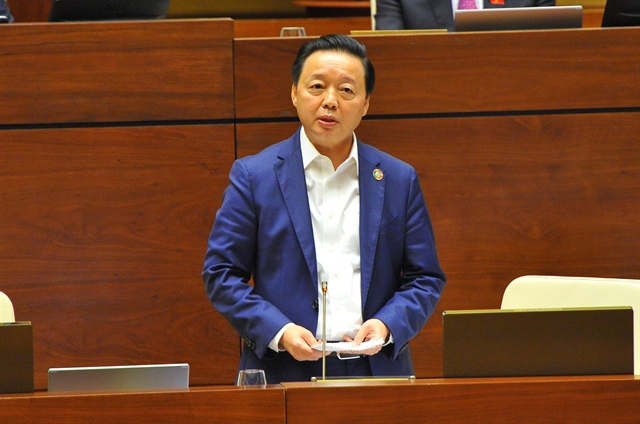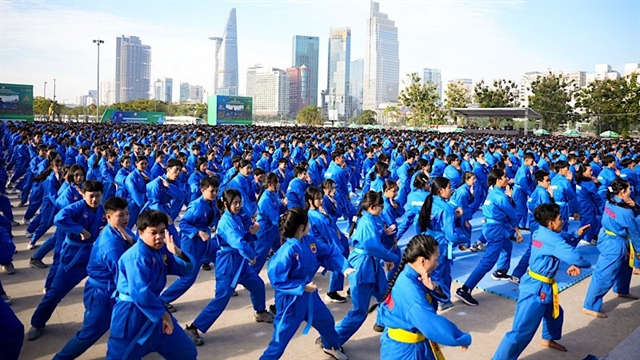.jpg) Politics & Law
Politics & Law


|
| Minister of Natural Resources and Environment Trần Hồng Hà speaks at the meeting on Saturday. — VNA/VNS Photo |
HÀ NỘI — National Assembly deputies discussed the draft of plans for national land use for the 2021-2030 period with a vision to 2050 and the 2021-2025 land use plan at the ongoing second session of the 15th legislature on Saturday.
Minister of Natural Resources and Environment Trần Hồng Hà had earlier presented a report on the draft and a verification report by the NA’s Economic Committee at the working session of the NA on Friday afternoon.
Minister Hà said the draft planning and the 2021-2025 land use plan aim to ensure enough land for the country’s socio-economic development strategy, laying a foundation to turn Việt Nam into a high-income developed nation by 2045.
NA deputies said the implementation of the plan creates important resources to boost socio-economic development and agreed with the need to approve the national land use planning for the 2021-2030 period, stressing that it needs to mitigate impacts on the environment.
Deputy Nguyễn Tuấn Anh from southern Long An Province said criteria that are related to the environment needed to follow the country’s development orientation for the next ten years of building a circular green, environmentally friendly economy and promoting the use of science and technology in waste treatment.
It was necessary for the Government to check these criteria towards downsizing the area of dumping stations and allocating land for waste treatment, he said.
The Government should review and adjust land use planning and land use plans to mitigate impacts on the environment and climate change, he said.
Regarding land for hi-tech industrial zone planning, the total area will reach 4,100ha by 2025. This was modest in comparison with the country’s development orientating, he said, proposing the Government adjust the planning to increase the land area for hi-tech parks.
Some deputies proposed paying more attention to the digital foundation in State land management to bring more benefits for both the economy and people, particularly when the country is preparing for socio-economic development recovery post-COVID-19 and safe adaptation to the pandemic.
Deputy Phạm Văn Thịnh from northern Bắc Giang Province said information technology application and digital transformation should be considered as a core solution and decisive factor in implementing land use planning and land use plans in the future.
Digital transformation in land management would help to improve the efficiency of examination and supervision tasks of authorised agencies and accelerate the making of land use planning and land use plans in the future as well as help ensure transparency in land use.
Some deputies suggested clarifying principles and criteria in the conversion of rice plantation land and protective forest land to non-agricultural land.
Deputy Mai Thị Phương Hoa from northern Nam Định Province said the reduction of rice cultivation land would lead to an increase in the number of unemployed workers in rural areas so she proposed to minimise the transfer of rice cultivation land into land for industrial development.
Some deputies said it was essential to publicise information relating to land planning for citizens to get access to prevent shortcomings and ensure transparency in implementing land policies.
Deputy Mai Văn Hải proposed to review land planning for industrial zones to prevent wastefulness. During 2011-20, land areas planned for industrial zones was over 191,000ha but only around 90,000ha of land was used.
Later the same day, Minister Hà explained and clarified some issues of concern.
He said land planning must be one step ahead and would serve as the foundation to guide spatial plans and orientations.
The minister said it was essential to identify "three boundaries" and "four areas" in land use planning.
The boundaries include "strict boundary" for protection and conservation such as special-use forest land, protective forests, rice cultivation land, lakes, ponds, and historical sites; boundary for development limitation such as areas of natural forests, corridors for protection of water sources, and wetlands; and development promotion boundary for conversion of purposes for economic and social development.
The “four areas” include the area for strict protection and conservation; the stable area with the restricted conversion of land use purpose; the area allowed to change land use purpose with specific conditions; and the area allowed to change land use purpose to guide space for other plannings.
The land-use plans were designed with the goal of allocating land to sectors and localities in accordance with socio-economic development needs, while simultaneously ensuring national defence-security and environmental protection, and climate change adaptation.
The land allocation must also meet the demand for infrastructure development, industrialisation, and urbanisation, while protecting ecologies and maintaining 3.5 million hectares of rice fields, according to the minister. — VNS

.jpg)
.jpg)

